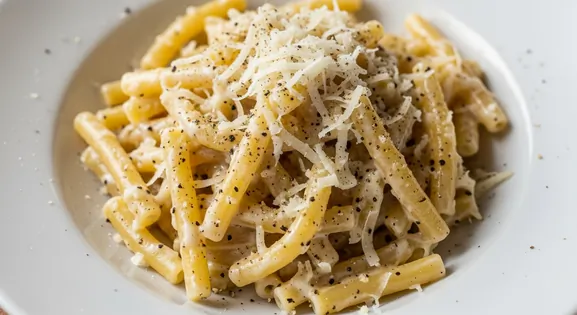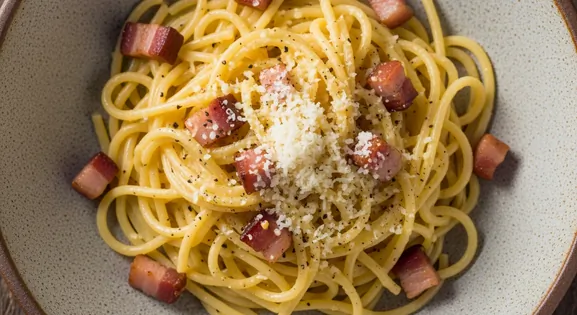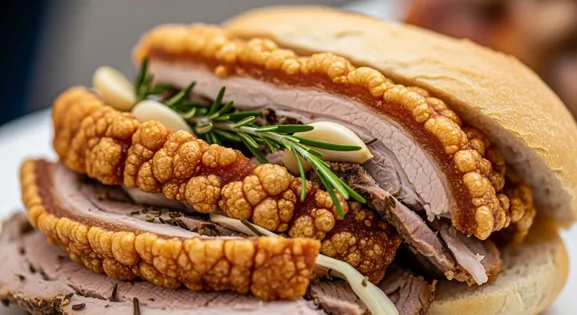Pinsa Romana (Roman Pinsa) in Rome
Pinsa Romana

Pinsa Romana (Roman Pinsa): A Local Culinary Staple
Stepping into a Roman pinseria, you immediately feel the city's culinary pulse. Pinsa Romana, with its unique oval shape and incredibly light, airy crust, offers a delightful departure from traditional pizza. It's a true local favorite, perfect for a casual meal or a quick bite while exploring Rome's charming streets.
New to Pinsa Romana (Roman Pinsa)? Learn all about its history in our complete guide.
Unlocking the Secrets of a Great Meal
Venture beyond tourist traps to neighborhoods like Testaccio or Trastevere, known for their authentic Roman eateries and high-quality pinserias frequented by locals.
Many authentic pinserias proudly display "Lunga Lievitazione" (long leavening) on their menus, indicating a highly digestible and flavorful dough.
Enhance your pinsa experience by pairing it with a local Roman craft beer (birra artigianale), often available at dedicated pinserias.
An Authenticity Guide
What to Look For
-
Dedicated 'Pinserie' with high turnover, especially in local neighborhoods like Testaccio or Prati
Busy spots frequented by Romans ensure pinsas are freshly baked and haven't been sitting long.
-
Pinsa baked fresh to order, visibly steaming
Ensures it's properly cooked and served at an optimal temperature. Look for ovens actively in use.
-
Light, airy crust with noticeable bubbles ('alveolatura')
This is a key characteristic of authentic Roman pinsa dough, indicating proper fermentation and quality.
-
Clean preparation areas and staff using gloves or tongs
Basic hygiene observation is crucial, especially for toppings applied after baking.
What to avoid
-
Stacks of pre-baked bases sitting out, especially near major tourist sites (Colosseum, Vatican)
These may be old or handled improperly. Authentic pinsa is typically stretched and topped just before baking.
-
Pinsas kept under heat lamps for extended periods
Can lead to uneven temperatures and dried-out toppings, compromising quality.
-
Overly cheap pinsa in high-traffic tourist areas
Extremely low prices might indicate compromise on ingredient quality or preparation standards.
-
Establishments with visibly dirty counters or ovens
Poor general hygiene is a significant indicator of compromised quality and care.
The Art of Ordering
When ordering a whole pinsa, you'll typically choose from a menu of classic and creative toppings. Don't hesitate to ask for recommendations or the 'pinsa del giorno' (pinsa of the day). For 'pinsa al taglio' (by the slice), point to your desired pieces; they'll be weighed and priced accordingly. It's common to eat 'al taglio' on the go, often folded in half. For whole pinsas, a fork and knife are usually provided, even in casual settings.
Exploring Rome for the Best Pinsa Romana (Roman Pinsa)
Trastevere
This vibrant, historic neighborhood is a prime spot for finding excellent pinserias, offering a lively atmosphere perfect for enjoying a casual meal. Look for places tucked away on side streets for a more authentic experience.
Piazza Trilussa, Santa Maria in Trastevere
Lunch, Dinner
Testaccio
A culinary heartland of Rome, Testaccio boasts numerous traditional eateries and highly-regarded pinserias. It's an ideal district to experience authentic Roman flavors, often with a more local crowd.
Testaccio Market, MACRO Testaccio
Lunch, Dinner
Prati
Located close to the Vatican, Prati offers a mix of traditional and modern pinserias. It's a convenient area for visitors to find quality pinsa after exploring St. Peter's Basilica or the Vatican Museums.
Vatican Museums vicinity, Cola di Rienzo shopping street
Lunch, Dinner
Monti
This charming, bohemian neighborhood in central Rome is home to several excellent pinserias, often nestled among artisan shops and historic buildings. It's a great spot for a relaxed meal.
Via Urbana, Piazza della Madonna dei Monti
Lunch, Dinner
Near Termini Station
While often bustling, the area around Termini Station hosts 'Pinsere', a renowned pinseria celebrated for its consistent quality and diverse, innovative toppings, making it a popular stop for locals and travelers alike.
Termini Station, Via Flavia
Lunch
Vendor Tips
- Look for pinserias with a visible oven and dough preparation area.
- Don't miss trying toppings inspired by Roman pasta classics (Amatriciana, Cacio e Pepe).
- 'Pinsere' is consistently rated highly but expect queues during peak times.
- 'Al taglio' places allow trying multiple flavors in smaller portions.
A Guide to Price, Portions, and More
Dietary Information
Important Note for Travelers: Your safety is our priority. Below are the common allergens associated with the traditional preparation of this dish. However, recipes and ingredients can vary significantly between establishments. Always confirm all ingredients directly with the food vendor before ordering, especially if you have a severe allergy.
Potential Allergens
Dietary Suitability
Price Guide
Budget Tips
- 'Pinsa al taglio' places offer good value, often priced by weight or slice (around 3-6 EUR per slice).
- Whole pinsas in pinserias range from 7-15 EUR depending on toppings and location.
- Neighborhood pinserias away from major tourist sites (like Colosseum, Vatican) might be slightly cheaper.
Serving & Seasonality
Served hot. Whole pinsas typically on plates/boards eaten with knife and fork. Slices ('al taglio') on paper, often folded ('a portafoglio').Best Times to Enjoy
- Lunch: Very popular, especially 'al taglio' for a quick meal (12 PM - 3 PM).
- Dinner: Common choice for a relaxed dinner (7:30 PM - 11 PM).
Seasonal Availability
Available year-round.
Culture and Customs
Local Significance
A defining feature of modern Roman casual dining. Represents a successful blend of tradition (marketing) and innovation (technique).
Eating Customs
- Using fork and knife for whole pinsas shows table manners.
- Folding 'al taglio' slices is practical for street eating.
- Often enjoyed with beer ('birra') or local wine ('vino della casa').
Unique Preparations of Pinsa Romana (Roman Pinsa)
Roman Classic Toppings
Strong prevalence of toppings featuring Pecorino Romano cheese, guanciale (cured pork jowl), artichokes ('carciofi' - seasonal), chicory ('cicoria'), and other local staples.
Pinsa 'Ripiena'
Less common variation where the pinsa dough might be folded over a filling like a calzone, but with the characteristic pinsa dough.
Practical Guides for Enjoying Pinsa Romana (Roman Pinsa)
Finding Authentic Pinsa Outside Roman Tourist Hubs
Learn how to identify and find genuine Pinsa Romana in Rome, venturing beyond the typical tourist areas to discover local favorites and ensure an authentic culinary experience.
- Explore Residential Neighborhoods: Venture into areas like Monteverde, Garbatella, or Trieste where local 'pinserie' cater to residents.
- Look for 'Lunga Lievitazione' Mentioned: Menus or signs indicating 'long leavening' (often 48-72 hours) signal authentic, digestible pinsa dough.
- Observe the Clientele: Shops busy with Romans during lunch (1-2:30 PM) or dinner (8 PM onwards) are usually reliable.
- Check Online Reviews by Locals: Use Italian search terms like 'migliore pinseria [neighborhood name]' to find local recommendations.
- Visit during Peak Hours: While avoiding massive crowds is good, visiting when the shop is moderately busy ensures higher turnover and fresher pinsa.
Ordering and Eating Pinsa Like a Roman
Master the art of ordering and enjoying Pinsa Romana in Rome, from selecting your preferred toppings to understanding local dining etiquette and drink pairings for an authentic experience.
- Specify Toppings Clearly: Menus can be extensive. Point or clearly state your desired topping combination. Classic Roman options include 'Amatriciana' or 'Cacio e Pepe' styles.
- Expect an Oval Shape: Don't be surprised by the non-circular shape; it's the defining feature of pinsa.
- Use Knife and Fork Initially: While casual, the airy crust can sometimes be easier to start with utensils before picking it up.
- Pair with Roman Drinks: Accompany your pinsa with a local 'birra artigianale' (craft beer) or a light Lazio white wine like Frascati.
- Eat Promptly: Pinsa is best enjoyed immediately after baking for optimal texture (crispy outside, soft inside).
Our Commitment to Quality
At Tasteplorers, our mission is to provide the most accurate and useful travel information in the world. To achieve this, all content on this site is created through our unique editorial framework. We utilize leading AI research tools, guided by our proprietary prompts, and a multi-stage validation process. This entire system is overseen by our editorial team to ensure everything we publish meets our high standards for accuracy, cultural nuance, and practical value for travelers.
Learn more about our Editorial Process and our Mission.
Countries
Explore regions
Europe
Discover Europe's diverse culinary landscape, from Mediterranean flavors to hearty Alpine fare. Learn to navigate markets, decode menus, and eat like a local.
Latin America & Caribbean
Discover the vibrant cuisines of Latin America & the Caribbean. Our expert guide covers everything from Mexican street food to Peruvian ceviche and market tips.
Oceania
Explore Oceania's diverse food scene. Learn about Polynesian earth ovens, Fijian feasts, and the vibrant café culture of Australia and New Zealand.
Southeast Asia
Explore Southeast Asia's diverse food cultures from Thailand to Vietnam. Get expert tips on navigating spice levels, choosing quality vendors, and understanding the rich traditions of the region.


